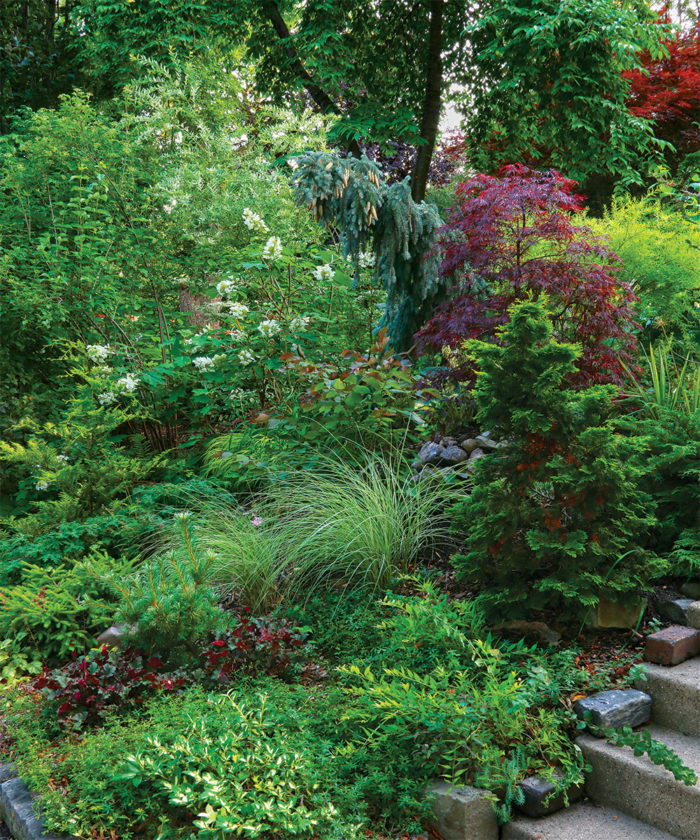
When it comes to gardening with trees and shrubs, it does take a little extra imagination to envision what those small nursery plants will look like in 10 to 20 years. Here’s a breakdown of our general process and an example of how a recently planted area in our garden came to life step-by-step.
First, we like to view a “to be planted” space from a distance—across the street, from different points on the sidewalk or path, even from the second-floor windows of the house. This helps us get an overall idea of what the scale of the planting needs to be in context.
Then we take numerous photos with our phone cameras to study the light and surrounding plantings. That helps us decide if we want a singular focal point or a grouping of plants to work as a focal point.
After the focal point is chosen, we note where the surrounding gaps are around the focal point and start imagining what color will pop and what size or texture will knit into the existing plants.
Finally, we make sure that the sizes and habits set up in a layered fashion. This process is complicated by a slope, because a plant that would be just the right size on a flat plane might be hidden by the plant above it when it’s put on the bank. Yet by using the incline of the bank, you can start to “step up” shrubs to get the layering just right.
Taller focal points are installed first to match the scale of the house and the large trees behind
1. Red Japanese maple (Acer palmatum cv., Zones 5–9)
2. ‘The Blues’ weeping blue spruce (Picea pungens ‘The Blues’, Zones 2–8) surrounding plants are chosen for their white coloring, which pops against the blue and red of the focal points.
3. Oakleaf hydrangea (Hydrangea quercifolia, Zones 5–9)
4. Dappled willow (Salix integra ‘Hakuro Nishiki’, Zones 4–9)
5. ‘Yellow Point’ dwarf mugo pine (Pinus mugo ‘Yellow Point’, Zones 2–8)
6. ‘Morning Light’ miscanthus (Miscanthus sinensis* ‘Morning Light’, Zones 5–9)
Weaver plants are chosen for their contrasting texture/color to the support plants already installed
7. Dwarf golden Hinoki cypress (Chamaecyparis obtusa ‘Nana Lutea’, Zones 5–9)
8. ‘Fernspray Gold’ Hinoki cypress (Chamaecyparis obtusa ‘Fernspray Gold’, Zones 4–8)
9. Bowles’ golden sedge (Carex elata ‘Aurea’, Zones 4–9)
10. ‘Golden Midget’ Serbian spruce (Picea omorika ‘Golden Midget’, Zones 4–8)
11. ‘Ogon’ spirea (Spiraea thunbergii ‘Ogon’, Zones 4–8) layering is completed by filling in the lower-level gaps with plants that echo the color of a focal point.
12. ‘Red Majestic’ contorted filbert (Corylus avellena ‘Red Majestic’, Zones 4–8)
13. Heuchera (Heuchera cv., Zones 4–9)
Favorite woody plants that never disappoint
Our list of treasured trees and shrubs is long and varied, but these options offer the best variety of color, shape, and texture.
*Invasive alert: Miscanthus (Miscanthus sinensis)
This plant is considered invasive in CT, GA, IL, IN, KY, MD, NC, NH, NJ, NY, PA, SC, TN, VA, WI.
Please visit invasiveplantatlas.org for more information.
Steve Bialk and Angela Duckert own Sanger House Gardens, a historic bed and breakfast located in the Brewer’s Hill section of downtown Milwaukee.
For more info on designing with trees and shrubs, check out Good Design Is Worth the Wait
Fine Gardening Recommended Products

DeWalt Variable-Speed Cordless Reciprocating Saw with 6-Piece Saw Blade Set
Fine Gardening receives a commission for items purchased through links on this site, including Amazon Associates and other affiliate advertising programs.
- 18.31 x 6.13 x 4 inches
- 1-1/8-inch stroke length
- Variable speed trigger with 0-3000 spm
- DW4856 Metal/Woodcutting Reciprocating Saw Blade Set, 6-Piece

Corona® Multi-Purpose Metal Mini Garden Shovel
Fine Gardening receives a commission for items purchased through links on this site, including Amazon Associates and other affiliate advertising programs.

Pruning Simplified: A Step-by-Step Guide to 50 Popular Trees and Shrubs
Fine Gardening receives a commission for items purchased through links on this site, including Amazon Associates and other affiliate advertising programs.

























Comments
Log in or create an account to post a comment.
Sign up Log in